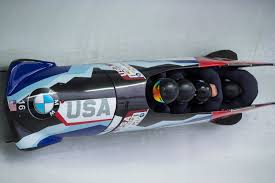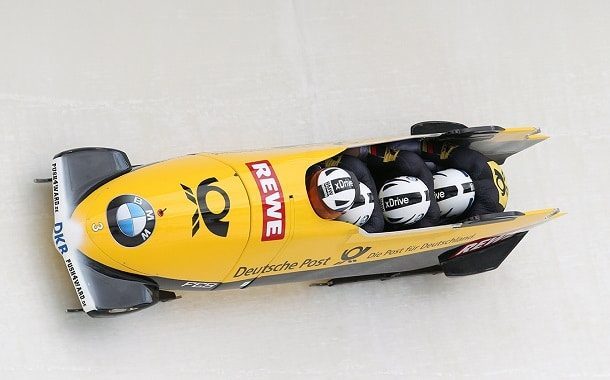How Much Does a Bobsled Cost?
Last Updated on February 23, 2024
Written by CPA Alec Pow | Content Reviewed by ![]() CFA Alexander Popinker
CFA Alexander Popinker
Bobsledding is a thrilling yet expensive winter sport. The sleek, aerodynamic sleds can reach speeds over 90 mph as they barrel down icy tracks. But competitive bobsleds aren’t cheap – purchasing and operating costs quickly add up. This article will break down the pricing for different types of bobsleds and the many additional expenses involved in bobsledding.
We’ll look at factors like manufacturing, technology, custom designs, and maintenance that influence bobsled costs. For aspiring pilots and brakemen, we’ll also explore budgeting strategies and financing options to make this exhilarating sport more accessible. Join us as we dive into the cold hard costs of bobsled ownership and operation.
How Much Does a Bobsled Cost?
There are two main types of bobsleds used in competition – 2-man and 4-man. The 2-man sleds are smaller and lighter, holding just a pilot and brakeman. 4-man bobsleds can fit up to four people, with two pilots in front controlling the sled.
2-man bobsleds typically cost $30,000 to $40,000. The pilot and brakeman are positioned in an inline seating configuration. The lighter sleds rely on speed and aerodynamics over pure power.
4-man bobsleds are larger and can run $50,000 to $80,000 new. The added size and weight allow them to generate more speed but require greater strength to push off at the start. These bobsleds seat two pilots in front and two brakemen in back in a side-by-side configuration.
NBC Sports Bay Area & California confirms that an Olympic-sized bobsled costs approximately $30,000, though prices can rise depending on the design. A women’s monobob, designed to encourage smaller country participation, costs $15,000.
Mt Van Hoevenberg lists the cost of a bobsled experience at $65 per session.
What Drives Bobsled Costs Up?
Several key factors influence the costs of bobsled manufacturing and customization:
Materials and Construction
Bobsleds have a steel frame surrounded by fiberglass, carbon fiber, and composite materials. The precise construction impacts the sled’s weight, structural integrity, and speed potential. Unique material mixes and labor-intensive hand-building drive prices up.
Innovative Design Elements
Cutting-edge aerodynamic elements like integrated fairings or fin shapes can boost speed but add complexity. Rigorous wind tunnel testing also gets factored into design costs.
Custom Features and Branding
Many bobsledders opt for custom paint jobs, graphics, and components tailored to their size and driving style, adding expense. Uniform branding and sponsorship displays also command premium pricing.
Technology Integration
Sensors, data acquisition systems, and camera mounts to analyze sled performance are growing in popularity. This high-tech integration increases costs for manufacturers and customers alike.
Buying New, Used, or Renting
For pilots seeking sled ownership, new and used markets both offer pros and cons:
New bobsleds provide the latest designs but carry premium prices. Manufacturers like Ferrari and BMW offer custom-built sleds approaching 6-figures for top racers.
Used sleds can run $10,000 to $30,000 – sometimes even ex-Olympic models. However, wear and tear require restoration, and older designs lose their competitive edge.
Rentals allow trying the sport more affordably, but access to equipment can be limited. Daily rates approach $500+ at some tracks.
Also check out our articles about the cost of skeleton sled racing, bungee jumping, and building a skating rink.
No matter what acquisition route racers take, additional investments will be required to keep any sled in peak condition.
Ongoing Bobsled Expenses Add Up
 Beyond just purchasing a sled, bobsledders face considerable costs to train, transport, store, and safely operate their equipment:
Beyond just purchasing a sled, bobsledders face considerable costs to train, transport, store, and safely operate their equipment:
- Maintenance and repairs – Bobsleds experience heavy stress and vibration, requiring regular maintenance, parts replacement, and repair expenses of $5,000+ annually.
- Transportation and storage – Transporting sleds to events on trucks and trailers run $5,000 to $10,000+ depending on distance and frequency. Off-season storage also incurs fees.
- Track time and training – Accessing ice tracks is mandatory for practice – daily rates run $500 to $1000+. Coaching, conditioning, and equipment add even more costs.
- Safety gear – Helmets, visors, sled suits, spiked shoes, and other gear are required. Specialized items like bobsled shoes can cost $200+. Outfitting each team member adds up.
- Entry fees – Top events like the World Cup charge teams thousands in entry fees alone, over $1500 per race. Travel, food, and lodging magnify expenses further.
For serious bobsledders, yearly operating costs routinely exceed $100,000 per team or athlete. The financial commitment required is on par with top-tier auto racing and other technical sports.
Creative Ways to Cover Bobsled Costs
The high costs of bobsled ownership and operation create barriers to entry into the sport. Thankfully, some creative options exist to offset expenses:
- Sponsorships from companies offer cash and equipment in return for branding placement on sleds and uniforms. Even small sponsors can chip in a few thousand.
- Crowdfunding campaigns through sites like GoFundMe let fans directly contribute to teams. These connections help raise thousands in grassroots support.
- Grants and organizations like the USA Bobsled and Skeleton Federation provide training access, coaching, and financial assistance to promising drivers.
- Used equipment purchases and renting slots on shared sleds also keep costs lower early on.
- Group ownership – Sharing sled expenses across four athletes makes the sport more affordable.
With persistence and grit, aspiring bobsledders have opportunities to defray the substantial costs and live out their ice-racing dreams.
Final Words
Bobsledding demands incredible athleticism, skill, and courage from its competitors. It also requires serious money. Between acquiring equipment, accessing training, and competing at the highest levels, bobsled pilots and crews take on major financial burdens.
Understanding the breakdown of bobsled costs, from purchase price to ongoing expenses, allows athletes to plan and budget realistically. Leveraging savings on purchases, operations, and maintenance is key. Partnering with sponsors and supporters offsets huge chunks of spending as well.
For those with determination, competitive drive, and funding savvy, fielding an elite bobsled team is possible. But entering the sport without clear eyes on the costs involved is surely a recipe for disaster. By keeping bobsled prices firmly in mind, pilots and crews give themselves the best chance to excel on ice while maintaining financial stability.
The financial thrill ride may equal the physical one, but thorough planning and preparation make bobsledding’s risks exhilarating instead of terrifying.
Frequently Asked Questions
How heavy is a bobsled empty?
An empty 2-man bobsled weighs approximately 170 kg (375 lbs). 4-man bobsleds are heavier, weighing approximately 210 kg (460 lbs) without crew. Despite being constructed from lightweight materials like fiberglass and carbon fiber, the solid steel frames plus running gear give empty sleds considerable heft.
This weight is vital to maintain speed and stability when loaded with crew members at the start of a run. But the mass makes vehicles difficult to maneuver and reinforces the need for customized equipment transport. Careful weight distribution and innovative materials allow modern bobsleds to deliver maximum performance.
How fast does a 4 man bobsled go?
Top 4-man bobsleds can reach speeds over 90 mph, with the current world record standing at 99 mph. The extra size and weight of 4-man sleds allows them to achieve higher top speeds than 2-man sleds, which max out around 85 mph.
Exploiting gravitational energy as they careen down icy tracks, well-designed 4-man bobsleds can feel like fighter jets on ice. The g-forces on tight turns are no joke either. Both crew skill and modern sled tech allow these blistering velocities – traction and control are just as essential as raw power.
Don’t let the skeletal frames fool you – a loaded bobsled at top speed is an absolute force of nature.
How hard is bobsledding?
Bobsledding is widely considered one of the most difficult and dangerous winter sports. Crew members must survive extreme speeds and g-forces while navigating treacherous tracks. Pilots face split-second steering challenges requiring total concentration.
Brakemen need almost superhuman leg strength to sprint-push sleds at the start. Even completing basic runs demands every ounce of physical and mental energy. Mastery takes years of relentless off-ice conditioning, technique practice, video analysis, and race experience.
The sport’s unforgiving nature quickly punishes even small errors. Olympic gold demands peak fitness, perfect team synergy, and fearless execution. For those few who rise to the challenge, bobsledding delivers incomparable thrills – but reaching that level carries a huge personal cost.


Leave a Reply
Want to join the discussion?Feel free to contribute!